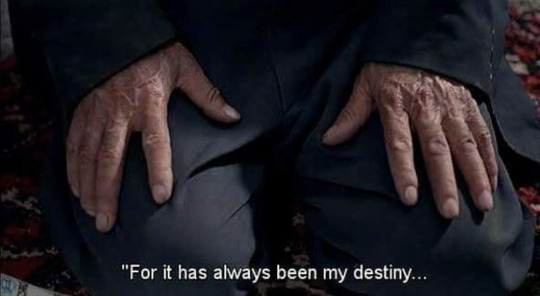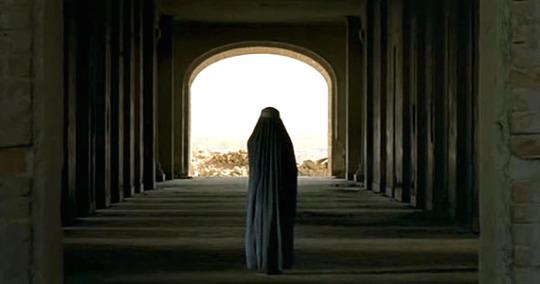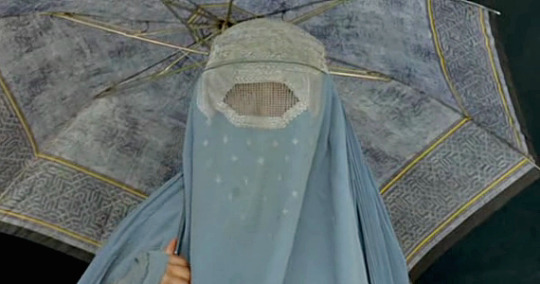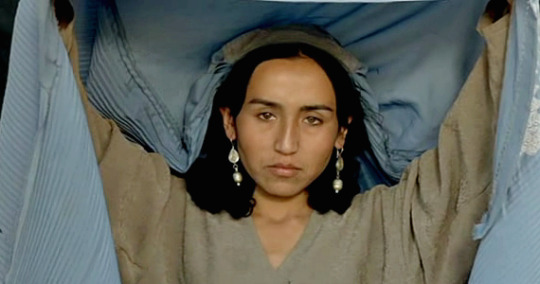#Samira Makhmalbaf
Explore tagged Tumblr posts
Text










THE APPLE (1998) dir. SAMIRA MAKHMALBAF
34 notes
·
View notes
Text

Happy 44th, Samira Makhmalbaf.
Photo by Piet Goethals.
8 notes
·
View notes
Text

Pizarra negra
تخته سیاه
Samira Makhmalbaf Kurdistán
2002
0 notes
Text


The Apple, Samira Makhmalbaf
896 notes
·
View notes
Text










The Apple (1998), dir. Samira Makhmalbaf
53 notes
·
View notes
Text
@wehadfaces tagged me. Thank you, darling.❤️
Rules: List your five all time favorite films and have people vote on which one matches your vibe.
Tagging: @keypix4, @pauvrecamille, @kpg-1126, @arathesane, @cecret-with-a-c, @nakedmonkey, @fanchonmoreau, @wickedheadache,@itsperfectlyreasonable and—to quote prev—anyone else who'd like to undertake the challenge of narrowing it down to five.
As always feel free to skip this.
6 notes
·
View notes
Text
youtube
Soy comunicadora social y una de mis grandes pasiones es el cine, ver cine, uno de mis primeros proyectos creativos fue un podcast (antes de que fueran famosos) de cine independiente, ANEMIC CINEMA, en honor a la obra de Marcel Duchamp, que se transmitía en un portal web de la universidad los domingos por la noche, EN VIVO. Era amor al arte.
Perseguí los menos rimbombantes del cine mundial: Samira Makhmalbaf, David Lynch, Alejandro Amenábar, Michael Winterbottom, Xavier Dolan, Spike Jones entre muchos otros
0 notes
Photo





Yggdrasil, 2022
https://drive.google.com/file/d/1JEx3FJo0ivyVzRLmTvk9muF0tS9NDu9G/view?usp=sharing
Yggdrasil formed as a group project as part of an Experimental Film module during my second year at the University of Bristol.
COLLECTIVE STATEMENT:
We decided to work with the topic “Landscape” but did not believe in strictly adhering to it, instead, experimenting with the initial idea and seeing where it would take us. Our experimental film project is the result of finding links between what we imagine are three different landscapes: the natural, the human, and the urban. This idea sprung directly from the assessment brief, as we agreed it was difficult to decide our focus between the topics “Landscape, “City,” and “Portrait” because of their overlaps.
We took inspiration from the films Samsara (dir. Ron Fricke, 2011) and Koyaanisqatsi (dir. Godfrey Reggio, 1982) in which striking images of nature are used as the primary means of storytelling. We first focused on capturing natural landscapes such as mountain ranges, beaches, textures found in nature, and natural monuments as we felt we had the clearest direction starting with them. Also, we could anticipate that capturing the natural landscapes would require the most time and effort, as we were all based within the city. We therefore began filming this section sooner than we began planning, which allowed the film to grow whilst we discovered a concrete and cohesive vision for it.
The film Blackboards (dir. Samira Makhmalbaf, 2000) inspired our use of “visual poetry.” In Blackboards, visual metaphors are used to link Kurdish identity to the landscape which they are bound to. Reflecting on her use of native nonactors, Makhmalbaf emphasises the “geography of the [Kurdish] faces” which reflect the rugged yet impressive mountainscapes of east Iran - a visual that inspired us (Makhmalbaf, S.). Like Makhmalbaf, we used visual and sonic “metaphors” “rhymes” and “repetitions” (terms taken from poetic techniques) to create comparisons between our three landscapes (nature, human, city). After each member of the collective had done some shooting, we came together with our nature footage. Together, we started making a web of connections between the clips based on their content, their primary forms, conceptual qualities, or tones. We then looked to cityscapes to find potential “rhymes” to contrast with our footage of natural landscapes, and shot the city elements as a group.
To do this, we explored the concept that cities can also be considered human-made landscapes, habitats and environments, suggesting a fundamental similarity to those in nature. Monuments are also seen in cities and many natural resources are used as materials to create the textures found in modern cities as well. We shot all of our own footage as it was important for us to interact with the spaces that our film focuses on. Many of our ideas for visual comparisons wouldn’t have been possible using found footage since we found that the visual comparisons truly revealed themselves only when we were out shooting and observing the world through our camera lenses.
We used the human body as another landscape, not only as a continuation of the metaphor taken from Blackboards, but also as a representation of the human experience as a whole. We started exploring the idea that humans originate from nature, our bodies are restrained to nature’s “rules” and can mimic nature’s landscapes. We filmed the human body, focusing particularly on its form and how at certain angles it can look like a mountain range, or other physical feature of the Earth. By incorporating the body with the various landscapes, we were able to visually explore how we as a species evolved from nature (which is something far more ancient and powerful than ourselves), and eventually constructed humanity’s own habitats, or “nature,” in the form of cities.
Through the use of: - a beat created by bodily sounds - a folk song from across continents - and a soundscape from an array of language samples (collected from people we personally know) We were able to centre on human development in the realm of speech and communication. We also suggest how humans overcame natural geography and all of its obstacles in order to be with one another in a globalised society.
The footage we accumulated only transformed into poetry during the edit, when we collaged the landscapes to create “impossible” images and sounds that part from reality. Visuals and sounds related to either nature, the human, or the city, are combined with other visuals and audio that either do or don’t correspond to their respective landscapes. Collaging these elements together into metaphors, reveals something more “contaminated”. We use the word “contaminated” to describe the way each element of our film relates to the other. Our three elements are each interwoven at some level (sonically or visually), and conceptually, they bleed into one another: humans come from nature; cities come from humans; hence nature and the city are intrinsically interconnected, and cities are also subject to entropy and the “rules” of nature as humans are. Hence, the spheres of nature and the newlyconstructed man-made nature contaminate one another. Our film turned into a collage of connections, leaning into experimental film characteristics of abandoning an emphasis on narrative.
Sonically, we blended sounds that came strictly from cities, nature, and human bodies. The film concept of spectatorship was something we played with later in the creative process as our edit progressed. For instance, while some sounds may be recognisable, they are attached to a different space than usual, muddling associations people usually have of certain sounds to certain places, which creates new meanings of contamination and connections between our three landscapes. The results of meshing the three landscapes are expressed as our images and sounds. This was only made possible through the tools that filmmaking provides us with, like editing and observing the world through a camera.
At the end, the film’s three landscapes reach a cumulative climax visually and sonically. Repeated digital lights are used to suggest concepts around increasing digitisation and globalisation that traverses geographical landscapes. Moreover, this briefly plays with the idea of a possible emerging virtual space, or digital landscape… Perhaps one that surpasses our identified natural and urban ones, as well as our own body’s physicality.
Filmography: - Blackboards (2000) Samira Makhmalbaf. Iran. Artificial Eye, Leisure Time Features, Wellspring Media. - Koyaanisqatsi (1982) Godfrey Reggio. United States. Island Alive, New Cinema. - Samsara (2011) Ron Fricke. United States. Oscilloscope Laboratories.
Bibliography: - Makhmalbaf, S. (2000) How Samira Made "The Blackboard". Iran: Makhmalbaf Film House. Available: https://www.youtube.com/watch?v=P8oF6m2DiJg (direct quote at 21:00, more implied comments at 38:21-39:00)
0 notes
Photo





At Five in the Afternoon , Samira Makhmalbaf , 2003.
713 notes
·
View notes
Photo

Seen in 2022:
The Apple (Samira Makhmalbaf), 1998
25 notes
·
View notes
Photo










Blackboards: ‘تخته سياه’ (Samira Makhmalbaf, 2000).
40 notes
·
View notes
Text
The Wunderkind Iranian Director Who Stopped Making Films

The Iranian director Samira Makhmalbaf last released a feature in 2008.Photograph by Piet Goethals / Reporters / Redux
By Richard Brody October 19, 2020
The Iranian filmmaker Samira Makhmalbaf is one of the best modern directors, and one of the most precocious of all time, but, even when the repertory houses were in high gear prior to the lockdown, her films were rarely shown. Makhmalbaf made her first feature, “The Apple,” in 1997, at the age of seventeen; her second, “Blackboards,” came out in 2000, and her third, “At Five in the Afternoon,” three years after that. All three display an artistry that is intensely of its time yet at the leading edge, and that is of its place yet reflects an international sensibility—and I’ve recently discovered that all are available to stream. Makhmalbaf expanded, intensified, and refined her artistry from film to film, becoming, by the age of twenty-three, one of the most original directors in the world. (I haven’t seen her fourth film, “Two-Legged Horse,” from 2008, which isn’t streaming anywhere.) She should have joined other rising filmmakers of the time in being considered, now, a modern master. Instead, for reasons unknown to me, she hasn’t made a film in more than a decade (nor left any trace of activity online at all).
Makhmalbaf is the scion of a cinematic dynasty. Her father, Mohsen Makhmalbaf (who co-wrote the script for “The Apple”), has been a leading Iranian director since the nineteen-eighties; her stepmother, Marziyeh Meshkini, has directed three features, including “The Day I Became a Woman,” from 2000; her younger sister, Hana, has directed two. In effect, the Makhmalbaf family is the Iranian counterpart to the Coppolas—and, remarkably, like Sofia Coppola’s first feature, “The Virgin Suicides,” from 1999, Samira Makhmalbaf’s first feature, “The Apple,” is a story of daughters imprisoned at home. It is also an amazing fusion of documentary and fiction, a dramatization of a real-life event reënacted by the actual people it concerned. (The version that’s currently streaming only has Spanish subtitles.)
The story is centered on a Tehran family, the Naderis, whose elderly patriarch, the father of twelve-year-old twin daughters, is so dogmatically religious that, in order to prevent them from even being glimpsed by males, he refuses to allow them to go out in public at all, ever, from birth onward—not to school, not to play, not to a store. The girls, Zahra and Massoumeh, remain imprisoned at home, locked behind two sets of gates inside the house. They have hardly even learned to speak; their gaits are cramped and awkward. Their mother, who is blind, accepts the patriarchal dictate. But when neighbors realize that there are children in the household, they call the authorities, and the father is forced, under pain of punishment, to let them out. Makhmalbaf lends the story a plainly polyphonic density, blending documentary footage with a true-crime drama, complete with denunciation, investigation, accusation, intervention, and the girls’ experience of liberation. Makhmalbaf films children with a vibrantly unsentimental empathy, capturing their sense of mischievous wonder and surprising autonomy; she also has a keen eye for spontaneous symbolism, such as mirrors and locks and the titular fruit itself, which is prominently featured and suggests dramas of self-consciousness and unnamed temptations and longings.
Makhmalbaf’s second feature, “Blackboards,” is also about oppressed children—it’s a story of violence, deprivation, and terror, set during the Iran-Iraq War, near the border, and centered on Kurdish people who’ve been forced to leave their home town of Halabja after it was subjected to a chemical-weapons attack. The title comes from blackboards that a group of itinerant teachers, in search of work, carry on their backs—and that also serve surprising purposes along the way, including as shields from incoming fire. The teachers can’t get students, which is to say that children in the region are getting no education. One teacher falls in with a group of boys who are “mules,” transporting contraband, at high risk, through the dangerous region; another teacher joins a large group of migrants heading toward the border—and, along the journey, marries a widowed young mother. It’s the teachers who get taught along the way—who find, in the struggle for survival amid the crossfire of two hostile powers, lessons that don’t come from their books. Makhmalbaf herself, in her documentary-rooted cinema, collects and preserves these lessons, and, moreover, lends a highly textured, symbolized identity to them by way of her discerning and composing eye. Her ironic vision doesn’t deride education but affirms it as a basis for recording and transmitting experience—as a model for her own cinema.

Agheleh Rezaie appears in Samira Makhmalbaf’s film “At Five in the Afternoon.”Photograph from RGR Collection / Alamy
Attention to heroic struggles amid horrors—and to the beauty that survivors embrace nonetheless—is heightened and deepened in “At Five in the Afternoon,” one of the great movies of life in wartime; it’s reportedly the first film made in Kabul after the fall of the Taliban. In it, Makhmalbaf goes further in her depiction of the urgency of education as a crucial springboard for progress. It’s a tale of two sisters-in-law amid the ruins of Kabul. Noqreh, who’s about twenty, isn’t allowed by her extremely devout father to go to school. With his horse-drawn cart, he brings her instead to a Koranic school, but she sneaks out: she removes her burqa, replaces her slippers with white high-heeled shoes, and heads to a large, outdoor, secular school for girls, where the teacher, a woman, encourages her students to become engineers, teachers, doctors, and even the President of Afghanistan—an idea that Noqreh takes very seriously. Leylomah, her sister-in-law, is married to Noqreh’s brother Akhtar, a truck driver who has vanished; they have an infant, who is starving to death because Leylomah, herself malnourished, can no longer produce milk.
“At Five in the Afternoon” is an appalled, grief-stricken movie filled with characters who’ve endured horrific losses. The film displays a city in ruins, unearths decades of political trauma, depicts ongoing violence, and reveals deep-rooted religious fanaticism—yet Makhmalbaf’s sense of teeming and intimate detail, as well as her passionate vision of the intellectual life, opens dimensions of inner experience as if forging a desperately sought political, material, and social reconstruction of the country. The dialectical element in Makhmalbaf’s first two films bursts out dominantly and proudly in “At Five in the Afternoon,” as in the teacher’s interrogations of her students—and the students’ incisive debate with one another. Challenged by a classmate on the issue of a Muslim woman becoming a head of state, Noqreh cites the example of Benazir Bhutto, in Pakistan. (The pushback that she gets is fascinating.) Encountering a French soldier on patrol, Noqreh engages him in a remarkable, unorthodox political discussion. When a large group of refugees arrives by truck from Pakistan, she speaks with a young man in the group about Bhutto, which gives rise to a warm and promising friendship. He’s a poet, and his recitation (in Dari) of a death-seared poem by Federico García Lorca gives the movie its title, forges their bond, and portends danger.
The filming of “At Five in the Afternoon” on location summoned Makhmalbaf’s most creative inspirations, a visual sensibility that her first two features only sketched, and which, here, bursts forth ecstatically from her surroundings. The film is a modern pictorial masterwork, featuring visions of a vigorous visual energy and a revelatory eye for the vestigial beauties, inspiring exertions, and incidental wonders of a ravaged city struggling toward rebirth. Scenes of the sea of young women’s faces (and, for that matter, of the white-scarved backs of their heads) in school, of the crowd of survivors from Pakistan alighting from trucks, of a burned-out airplane fuselage that serves as a shelter, and of a vast ruined compound where the central family takes refuge have a pointillistic specificity and a monumental power that matches the passionate intimacy of Makhmalbaf’s closeup portraiture. Her trenchant visual composition while on location (she and Ebrahim Ghafori did the cinematography), her documentary-rooted sense of exquisite style, is both a mark of her art and of the times—it connects her cinematic sensibility with those of Wes Anderson and, again, Sofia Coppola, whose documentary views of Tokyo in “Lost in Translation,” made at just about the same time, are similarly distinctive.
Yet Anderson and Coppola have made a batch of major films since then, and I’ve long wondered why Makhmalbaf has not. We served together on a film-festival jury, in 2003, but haven’t been in touch since then; recent attempts to contact her through her family’s film Web site and phone calls to the Makhmalbaf company’s office went unanswered. A piece in Screen Daily from last November describes the tribulations of the Makhmalbafs, who have been living in London since 2011. Her father, who was politically persecuted in Iran, left the country in 2005; Makhmalbaf and her stepmother, who are also in exile, have been denied passports by the British government. And it turns out that, in this year’s push by the Academy of Motion Picture Arts and Sciences to expand the ranks of Oscar voters, one of the eight hundred and nineteen newly invited members is Samira Makhmalbaf. (It’s not clear whether she has actually accepted.) Her voice may count there—but her cinematic voice, one of the most vital of our time, is conspicuous in its absence.
9 notes
·
View notes
Photo

Blackboards (2000) Samira Makhmalbaf
12 notes
·
View notes
Photo










The Apple (Makhmalbaf, 1998)
62 notes
·
View notes
Photo

Happy 41st, Samira Makhmalbaf.
15 notes
·
View notes




